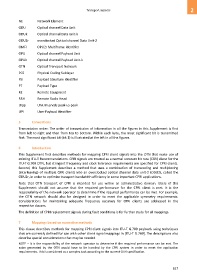Page 637 - 5G Basics - Core Network Aspects
P. 637
Transport aspects 2
NE Network Element
ODU Optical channel Data Unit
ODUk Optical channel Data Unit-k
ODU2r overclocked Optical channel Data Unit-2
OMFI OPU2r Multiframe Identifier
OPU Optical channel Payload Unit
OPUk Optical channel Payload Unit-k
OTN Optical Transport Network
PCS Physical Coding Sublayer
PSI Payload Structure Identifier
PT Payload Type
RE Remote Equipment
RRH Remote Radio Head
UIpp Unit Intervals peak-to-peak
UPI User Payload Identifier
5 Conventions
Transmission order: The order of transmission of information in all the figures in this Supplement is first
from left to right and then from top to bottom. Within each byte, the most significant bit is transmitted
first. The most significant bit (bit 1) is illustrated at the left in all the figures.
6 Introduction
This Supplement first describes methods for mapping CPRI client signals into the OTN that make use of
existing ITU-T Recommendations. CPRI signals are treated as a normal constant bit rate (CBR) client for the
ITU-T G.709 OTN, but stringent frequency and clock tolerance requirements are specified for CPRI clients.
Second, this Supplement describes a method that uses a combination of transcoding and multiplexing
(interleaving) of multiple CPRI clients into an overclocked optical channel data unit-2 (ODU2), called the
ODU2r, in order to optimize transport bandwidth efficiency in some important CPRI applications.
Note that OTN transport of CPRI is intended for use within an administrative domain. Users of this
Supplement should not assume that the required performance for the CPRI client is met. It is the
responsibility of the network operator to determine if the required performance can be met. For example,
the OTN network should also be designed in order to meet the applicable symmetry requirements.
Considerations for maintaining adequate frequency accuracy for CPRI clients are addressed in the
respective clauses.
The definition of CPRI replacement signals during fault conditions is for further study for all mappings.
7 Mappings based on normative methods
This clause describes methods for mapping CPRI client signals into ITU-T G.709 payloads using techniques
that are currently defined for use with other client signal mappings in [ITU-T G.709]. The descriptions also
describe special considerations that may be needed.
NOTE – It is the responsibility of the network operator to determine if the required performance can be met. The
noise generated by the OTN would have to be handled by the CPRI system in order to meet the application
requirements. This is considered as a complex task according to the current OTN specification.
627

